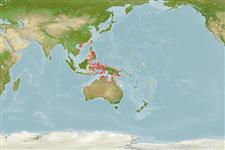Classification / Names
Common names from other countries
Main reference
Size / Weight / Age
Max length : 17.8 cm TL male/unsexed; (Ref. 1555)
Environment
Marine; demersal
Climate / Range
Tropical, preferred ?
Distribution
Short description
Dorsal
spines
(total): 9;
Dorsal
soft rays
(total): 10;
Anal
spines: 3;
Anal
soft rays: 7. U-shaped premaxilla groove fully scaled in specimens over 16 cm SL, producing a broadly rounded margin of the scaled area level with the anterior nostrils (partially scaled in 10 cm SL specimens). Posterior margin of maxilla beyond a vertical through anterior margin of inner dermal eye opening. Scales between 5th dorsal fin spine base 3.5 or 4. Body silvery, bands on body lacking or 6-8 irregular, very faint or dusky, oblique and vertical bands dorsolaterally and ventrolaterally (usually more apparent in young stressed or preserved specimens. Pelvic fin semi-transparent with a faint dusky band and indistinct white distal margin posteriorly or colorless when fresh. Spinous dorsal fin with an indistinct dusky patch (2nd-6th spines) and very narrow dusky distal margins on upper membranes between spines. Supraneural bones 3 (Ref. 35850).
IUCN Red List Status (Ref. 115185)
Threat to humans
Harmless
Human uses
More information
Common namesSynonymsMetabolismPredatorsEcotoxicologyReproductionMaturitySpawningFecundityEggsEgg development
ReferencesAquacultureAquaculture profileStrainsGeneticsAllele frequenciesHeritabilityDiseasesProcessingMass conversion
Tools
Special reports
Download XML
Internet sources
Estimates of some properties based on models
Phylogenetic diversity index
PD50 = 0.5000 many relatives (e.g. carps) 0.5 - 2.0 few relatives (e.g. lungfishes)
Trophic Level
3.3 ±0.3 se; Based on size and trophs of closest relatives
Resilience
High, minimum population doubling time less than 15 months (Preliminary K or Fecundity.)
Vulnerability
Low vulnerability (14 of 100)
Price category
